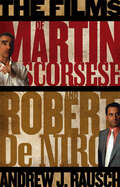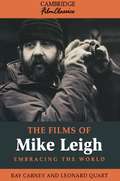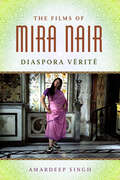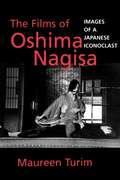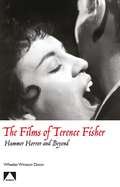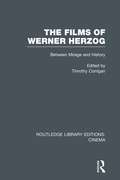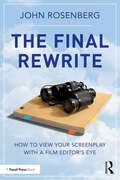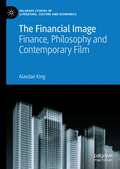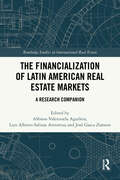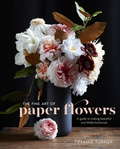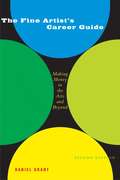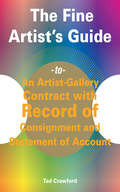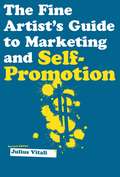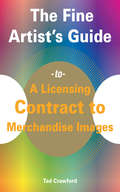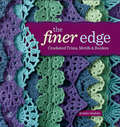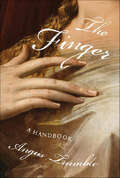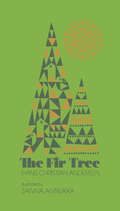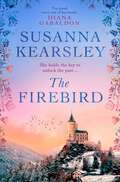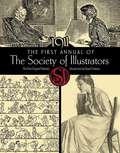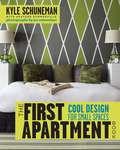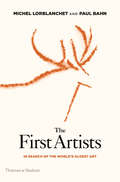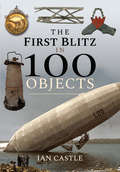- Table View
- List View
The Films of Martin Scorsese and Robert De Niro
by Andrew J RauschIn 1973, early in their careers, Martin Scorsese and Robert De Niro collaborated for the first time. Over the next few decades, they worked together on seven more movies, many of which brought them both acclaim and awards. And while successful director and actor pairings have occurred throughout the history of film, few have fashioned so many works of enduring value as these two artists. In little more than two decades, Scorsese and De Niro produced eight features, including the classics Taxi Driver, Raging Bull, and GoodFellas. In The Films of Martin Scorsese and Robert De Niro, Andrew J. Rausch examines the creative output of this remarkable pair, from their initial offering, Mean Streets, to their most recent film together, Casino. Rausch looks at their relationship as individual artists who worked together to create cinematic magic, as well as the friendship that was forged nearly 40 years ago. Drawing upon interviews and other sources, Rausch goes behind the scenes of their eight films, providing insi
The Films of Mike Leigh
by Ray Carney Leonard QuartThe Films of Mike Leigh is the first critical study of one of the most important and eccentric directors of British independent filmmaking. Although active since 1971, Leigh has only come to the attention of an international audience in the 1990s through films such as Secrets and Lies and Career Girls. Like Robert Altman and John Cassevetes, Leigh works improvisationally, beginning with a small group of actors around whom he builds his films during months of private rehearsal. The script is written during this process. Ray Carney examines Leigh's working method and films in the intellectual and social contexts in which they were created. He argues that Leigh cannot be simply considered within the British realist tradition of Osborne and Loach. All of Leigh's major box office successes, including Naked, Life is Sweet and High Hopes, are analyzed, interpreted, and shown to be among the finest examples of cinema.
The Films of Mira Nair: Diaspora Verite
by Amardeep SinghThe Films of Mira Nair: Diaspora Vérité presents the first, full-length scholarly study of her cinema. Mira Nair has broken new ground as both a feminist filmmaker and an Indian filmmaker. Several of her works, especially those related to the South Asian diaspora, have been influential around the globe. Amardeep Singh delves into the complexities of Nair’s films from 1981 to 2016, offering critical commentary on all of Nair’s major works, including her early documentary projects as well as shorts. The subtitle, “diaspora vérité,” alludes to Singh’s primary theme: Nair’s filmmaking project is driven aesthetically by her background in the documentary realist tradition (cinéma vérité) and thematically by her interest in the lives of migrants and diasporic populations. Mainly, Nair’s filmmaking intends to document imaginatively the experiences of diasporic communities.Nair’s focus on the diasporic appears in the long list of her films that have explored the subject, such as Mississippi Masala, So Far from India, Monsoon Wedding, The Perez Family, My Own Country, The Namesake, and The Reluctant Fundamentalist. However, a version of the diasporic sensibility also emerges even in films with an apparently different scope, such as Nair’s adaptation of Thackeray’s Vanity Fair.Nair began her career as a documentary filmmaker in the early 1980s. While Nair now has largely moved away from the documentary format in favor of making fictional feature films, Singh shows that a documentary realist style remains active in her subsequent fictional cinema.
The Films of Orson Welles
by Charles HighamThis title is part of UC Press's Voices Revived program, which commemorates University of California Press’s mission to seek out and cultivate the brightest minds and give them voice, reach, and impact. Drawing on a backlist dating to 1893, Voices Revived makes high-quality, peer-reviewed scholarship accessible once again using print-on-demand technology. This title was originally published in 1970.This title is part of UC Press's Voices Revived program, which commemorates University of California Press’s mission to seek out and cultivate the brightest minds and give them voice, reach, and impact. Drawing on a backlist dating to 1893, Voices Revived</DIV
The Films of Oshima Nagisa: Images of a Japanese Iconoclast
by Maureen TurimThis study of the films of Oshima Nagisa is both an essential introduction to the work of a major postwar director of Japanese cinema and a theoretical exploration of strategies of filmic style. For almost forty years, Oshima has produced provocative films that have received wide distribution and international acclaim. Formally innovative as well as socially daring, they provide a running commentary, direct and indirect, on the cultural and political tensions of postwar Japan. Best known today for his controversial films In the Realm of the Senses and The Empire of Passion, Oshima engages issues of sexuality and power, domination and identity, which Maureen Turim explores in relation to psychoanalytic and postmodern theory. The films' complex representation of women in Japanese society receives detailed and careful scrutiny, as does their political engagement with the Japanese student movement, postwar anti-American sentiments, and critiques of Stalinist tendencies of the Left. Turim also considers Oshima's surprising comedies, his experimentation with Brechtian and avant-garde theatricality as well as reflexive textuality, and his essayist documentaries in this look at an artist's gifted and vital attempt to put his will on film.
The Films of Terence Fisher: Hammer Horror and Beyond (Auteur Ser. #No. 26)
by Wheeler Winston DixonTracing the entire career of the British director Terence Fisher, best known for his Gothic horror films for Hammer—such as The Curse of Frankenstein (1957) and Dracula (1958)—The Films of Terence Fisher covers not only his horror films, but also his film noirs, comedies, and early apprenticeship work to create a full picture of Fisher's life and work.Brimming with rare stills, interviews, and detailed analysis of Fisher's films—both for Hammer as well as his earlier work—this is the ultimate "one-stop" book on Terence Fisher, both in his horror films, and his entire body of work, as well as his legacy to the British cinema.
The Films of Werner Herzog: Between Mirage and History (Routledge Library Editions: Cinema)
by Timothy CorriganGiven Herzog’s own pronouncement that ‘film is not the art of scholars, but of illiterates,’ it is not surprising that his work has aroused ambivalent and contradictory responses. Visually and philosophically ambitious and at the same time provocatively eccentric, Herzog’s films have been greeted equally by extreme adulation and extreme condemnation. Even as Herzog’s rebellious images have gained him a reputation as a master of the German New Wave, he has been attacked for indulging in a romantic naiveté and wilful self-absorption. To his hardest critics, Herzog’s films appear as little more than Hollywood fantasies disguised as high seriousness. This book is an attempt to illuminate these contradictions. It gathers essays that focus from a variety of angles on Herzog and his work. The contributors move beyond the myths of Herzog to investigate the merits of his work and its place in film history. A challenging range of films is covered, from Fata Morgana and Aguirre, the Wrath of God to more recent features such as Nosferatu and Where the Green Ants Dream, offering the reader ways of understanding why, whatever the controversies surrounding Herzog and his films, he remains a major and popular international filmmaker. Orignally published in 1986.
The Final Rewrite: How to View Your Screenplay with a Film Editor’s Eye
by John RosenbergThis book offers a unique perspective on crafting your screenplay from an editor’s point-of-view. Special features include before and after examples from preproduction scripts to post production final cuts, giving screenwriters an opportunity to understand how their screenplay is visualized in post production. By the time a script reaches the editing room, it has passed through many hands and undergone many changes. The producer, production designer, director, cinematographer, and actor have all influenced the process before it gets to the editor’s hands. Few scripts can withstand the careful scrutiny of the editing room. This book reveals how to develop a script that will retain its original vision and intent under the harsh light of the editing console. It provides insights that writers (as well as producers and directors) need and editors can provide for a safe journey from the printed page to the final release. This book is ideal for aspiring and early career screenwriters, as well as filmmakers and established screenwriters who want to gain a better understanding of the editing process.
The Final Years of London Midland Region Steam: A Pictorial Tribute
by David MatherExtensively illustrated with photos, a history of the many locomotives that became part of this British Railways region.This book investigates the vast number of locomotives that came to the London Midland Region in 1948 upon the nationalization of the four largest railway companies in the UK. It is a class-by-class survey with over two hundred illustrations, covering all the top link and freight classes and also looking at the smaller types of locomotive, operating on branch lines and doing more humble tasks.The author explores what happened to them, and also looks at those that eventually made their way into preservation.
The Financial Image: Finance, Philosophy and Contemporary Film (Palgrave Studies in Literature, Culture and Economics)
by Alasdair KingThe Financial Image: Finance, Philosophy, and Contemporary Film draws on a broad range of narrative feature films, documentaries, and moving image installations in the US, Europe, and Asia. Using frameworks from contemporary philosophy and critical finance studies, the book explores how contemporary cinema has registered recent financial and economic issues. The book focuses on how filmmakers have found formal means to explore, celebrate, and critique the increasingly important role that the financial sector plays in shaping global economic, political, ethical, and social life.
The Financialization of Latin American Real Estate Markets: A Research Companion (Routledge Studies in International Real Estate)
by Alfonso Valenzuela Aguilera Luis Alberto Salinas Arreortua José Gasca ZamoraThe Financialization of Latin American Real Estate Markets: A Research Companion provides an authoritative overview of the real estate asset class in Latin America with chapters covering Mexico, Brazil, Argentina, Colombia, Nicaragua and Chile. The focus is on the current academic research and its relevance for practical applications and is divided into four key themes: real estate-related wealth and macroeconomics, housing price dynamics and affordability, financial crises and structural change, and non-residential real estate. The contributors cover the institutional context for real estate investment, the main players in real estate investment finance in Latin America, real estate appraisal and performance measurement, and real estate portfolios and risk management. The purpose of this book is to provide an informed overview of urban economics theory applied to financial real estate markets and capital investments practices. This analysis primarily focuses on the financial mechanisms using debt, mortgages, and equity positions to operate these markets. The regional focus on Latin America reflects on the way in which cities follow similar patterns in the design of Housing policies and programs, the mechanisms to produce infrastructures and the growing disparities that the allocation of large investments is producing among its citizens. Real estate represents an increasingly significant global asset class and investors and researchers must understand its distinctive characteristics in the region. Providing a comprehensive reference for students, academics and professionals studying, researching and working in real estate investment, finance and economics, this cutting-edge volume will pave the way for future research.
The Fine Art of Paper Flowers: A Guide to Making Beautiful and Lifelike Botanicals
by Aya Brackett Tiffanie TurnerAn inspiring, practical and gorgeous guide to crafting the most realistic and artful paper flowers for arrangements, art, décor, wearables and more, from San Francisco botanical artist Tiffanie Turner. The Fine Art of Paper Flowers is an elevated art and craft guide that features complete step-by-step instructions for over 30 of Tiffanie Turner’s widely admired, unique, lifelike paper flowers and their foliage, from bougainvillea to English roses to zinnias. In the book, Turner also guides readers through making her signature giant paper peony, shares all of her secrets for special paper treatments, candy-striping, playing with color and creating botanical imperfections, and shows how to turn paper flowers into gorgeous garlands, headdresses, bouquets and more. These stunning creations can be made from simple and inexpensive materials and the book's detailed tutorials and beautiful photography make it easy to achieve dramatic and lifelike results.
The Fine Artist's Career Guide: Making Money in the Arts and Beyond
by Daniel GrantThis indispensable guide gives anyone with studio art training the vital tools and breadth of information they need to develop and succeed in the fine and applied arts. It covers the full spectrum of career options available to artists today-from being an independent artist to niches in the corporate world, and from jobs that require special artistic skills to those calling for artistic improvisation.
The Fine Artist's Guide to A Commercial Lease
by Tad CrawfordPart of The Fine Artist's Guide series, this classic guide provides information about issues relevant to artists today. It explains how to approach a commercial lease and what responsibilities one may encounter when renting for commercial purposes. This guide explains three types of leases (Form 20, 21, 22) and their provisions, includes a sample commercial lease contract, and contains helpful negotiation checklists.
The Fine Artist's Guide to An Artist-Gallery Contract with Record of Consignment and Statement of Account
by Tad CrawfordPart of The Fine Artist's Guide series, this classic guide provides information about issues relevant to artists today. Consignment is when your property is placed in the hands of another individual or institution but your ownership is retained until the material is sold. This guide shows you how to draft a contract that addresses commission upon sale, stipend, exclusive rights, potential damages, and more. It contains a sample of Form 7 (the Artist-Gallery Contract) and a helpful negotiation checklist.
The Fine Artist's Guide to Marketing and Self-Promotion: Innovative Techniques to Build Your Career as an Artist
by Julius VitaliFilled with innovative tips and advice for the fine artist on a budget, The Fine Artist's Guide to Marketing and Self-Promotion teaches you how to function as your own press agent. Learn how to create attention grabbing publicity videos, press releases, and e-mails; exhibit and publish your work in magazines and newspapers; assemble grant proposals; write effective résumés; use slides, CDs, Web sites, and other photographic and digital reproductions to get your work into the public eye, and how to qualify for arts-in-education residencies and artists' communities.This updated book also features extensive listings of organizations, services, publications, and other vital resources, along with in-depth profiles of successful artists who have developed effective techniques for marketing and promoting their work. If you're ready to take charge of your art career, you can't afford to be without the information contained in this handy guide.
The Fine Artist's Guide to a License Contract to Merchandise Images
by Tad CrawfordPart of The Fine Artist's Guide to series, this classic guide includes information about the issues relevant to artists today. Granting others the rights to use images created by an artist for posters, calendars, greeting cards, stationery, apparel, wallpaper, mugs and other household items can be extremely lucrative. This guide details the appropriate steps an artist should take when interested in merchandising images and includes a sample contract and a negotiation checklist.
The Finer Edge: Crocheted Trims, Motifs & Borders
by Kristin OmdahlAn innovative collection of 40 stitch and 12 garment patterns from best-selling author Kristin Omdahl, The Finer Edge demonstrates various techniques, construction methods, and versatile applications for crochet edgings.While crochet edgings are customarily used to trim or finish blankets and garments, designer Kristin Omdahl treats you to both traditional and novel new ways to expand your use of edgings. You will learn how edging patterns can be used to create entire fabrics, reformatted to make individual decorative motifs, reverse-engineered from existing fabrics, and even used to create three-dimensional designs. Focusing on construction techniques for edgings, The Finer Edge is divided into separate sections based on top-down, sideways, and bottom-up methods to help guide the reader.Though there are 12 project patterns that highlight the edgings, you'll be inspired to creatively mix and match within each edging's section. Also included in this gorgeous book are charts, illustrations, and photographs of crochet swatches and a pattern collection that includes multiple sizes, including plus sizes.Discover innovation at its finest with The Finer Edge.
The Finger: A Handbook
by Angus TrumbleFROM THE AUTHOR OF A BRIEF HISTORY OF THE SMILE, A COMPLETE INDEX OF THE DIGIT In this collision between art and science, history and pop culture, the acclaimed art historian Angus Trumble examines the finger from every possible angle. His inquiries into its representation in art take us from Buddhist statues in Kyoto to the ceiling of the Sistine Chapel, from cave art to Picasso's Guernica, from Van Dyck's and Rubens's winning ways with gloves to the longstanding French taste for tapering digits. But Trumble also asks intriguing questions about the finger in general: How do fingers work, and why do most of us have five on each hand? Why do we bite our nails? This witty, odd, and fascinating book is filled with diverse anecdotes about the silent language of gesture, the game of love, the spinning of balls, superstitions relating to the severed fingers of thieves, and systems of computation that were used on wharves and in shops, markets, granaries, and warehouses throughout the ancient Roman world. Side by side with historical discussions of rings and gloves and nail polish are meditations on the finger's essential role in writing, speech, sports, crime, law, sex, worhsip, memory, scratching politely at eighteenth-century French doors (instead of crudely knocking), or merely satisfying an itch—and, of course, in the eponymous show of contempt.
The Fir Tree
by Hans Christian Andersen Tiina Nunnally Sanna AnnukkaGorgeously packaged with intricate illustrations from Finnish illustrator, Sanna Annukka, this new edition of Hans Christian Andersen's well-loved fairy tale, The Fir Tree, is the perfect holiday gift for adults and children alike.Hans Christian Andersen's tragic tale of naive greed and dissatisfaction is retold through the striking and contemporary illustrations of Finnish illustrator Sanna Annukka. Cloth-bound in rich forest green, with gold foil embellishments, The Fir Tree is elevated from a children's book to a unique work of art and makes an ideal gift for people of all ages.
The Firebird: A story of love, sacrifice, courage and redemption (The\scottish Ser. #2)
by Susanna KearsleyFrom the New York Times bestselling author of The Winter Sea and The Vanished Days When a woman brings a small wooden carving into the art dealership, claiming it once belonged to a Russian Empress, Nicola Marter&’s boss believes it is worthless. But Nicola has an unwanted, if rare, psychic gift. Holding 'The Firebird' in her hands, she knows this woman is telling the truth. Compelled to uncover its true history, Nicola must put her own past behind her. She contacts an old flame who can access the past in a way no one else can. Together they can find the real story of 'The Firebird'… Following history from Scotland, to Belgium and to St Petersburg, The Firebird is a sweeping story of love, sacrifice, courage and redemption. A journey that spans centuries and lifetimes to connect the past with the future. Praise for Susanna Kearsley &‘Sometimes an author catches lightning in a bottle, and Susanna Kearsley has done just that&’ New York Journal of Books &‘A deeply engaging romance and a compelling historical novel&’ Bernard Cornwell, author of The Last Kingdom &‘Kearsley is nothing less than a magician weaving together the past and the present in yet another marvellous, genre-bending, romantic, mysterious and utterly unputdownable novel&’M J Rose, author of Seduction &‘Will stay with you long after you put it down. Her deft touch with historical intrigue is matched only by her delivery of a contemporary heroine who is as unique as she is memorable&’Deanna Raybourn, author of The Dark Enquiry &‘Fascinating, immersive and twisty – twists not only of plot, but of character and time&’Diana Gabaldon, author of the Outlander series
The First Annual of the Society of Illustrators, 1911
by Society of Illustrators Royal CortissozA New York City–based institution founded in 1901, the Society of Illustrators remains dedicated to promoting the art of illustration. Ten years after its 1901 founding, the organization resolved to publish an annual compilation of the year's best illustrations by its members. The custom endures to the present day, and the Illustrators Annual remains among the most prestigious publications in its field. This, the first of the organization's annuals, features 85 images by several of the most influential illustrators of the twentieth century, including Frederic Remington, James Montgomery Flagg, Franklin Booth, Charles Dana Gibson, and many others. This new edition reprints the original publication's Introduction by Royal Cortissoz, a highly regarded art critic of the day. Past Society president Dennis Dittrich provides a Foreword, setting the work in context for today's readers and modern-day students of illustration.
The First Apartment Book: Cool Design for Small Spaces
by Kyle SchunemanBreak out of the white-walled world of first apartments and tap in to your blue-sky decorating dreams with star designer Kyle Schuneman's smart, bold ideas for any budget. First apartments are so exciting because you can finally do what you want with your own space, but they can be tricky to decorate. Kyle Schuneman knows that a paper-thin wallet and four plain walls don't have to stand between you and your perfect home. Kyle, 26, is a decorating prodigy who has designed first apartments for friends, clients, and himself, braving logic-defying floor plans, space-challenged rooms, and picky landlords. In The First Apartment Book, Kyle shares brilliant design ideas and thirty simple DIY projects that show how anyone can infuse a first home with personality whether you're renting, moving in with a roommate or significant other for the first time, or are a newly minted owner eager to put your stamp on your place. The First Apartment Book is both a tour of amazing photographs from ten real homes across the country and a hardworking resource of great ideas. Kyle explains how each of the featured apartments achieves the perfect balance between cool design and the homeowner's lifestyle, with a sprinkling of influences from the resident's city thrown in. Kyle scours flea markets for functional pieces with personality and incorporates Pollock-inspired art and touches of taxicab yellow to make a small studio in New York City function as four different yet coherent rooms. o Graffiti-like dip-dye curtains and a skateboard table reflect a Seattle renter's hip sensibility. In Cleveland, Kyle creates a modern preppy space for a plaid-loving local using subdued colors and careful pattern mixing. A couple's salon-style hanging of rock posters in Nashville feels utterly unique, and Kyle's clever ideas for storing to store their musical instruments keep the duo sane. Short on time and long on style, the thirty DIY projects include no-sew pillows, yarn-wrapped picture frames, and a dresser update using a little glue and fabric. Full of bold, vibrant photos and hundreds of big ideas for small spaces, The First Apartment Book proves that no matter what your landlord, your floor plan, or your wallet says, there are no limits on how cool your first apartment can be.
The First Artists: In Search Of The World's Oldest Art
by Paul Bahn Michel Lorblanchet Pierre SoulagesTwo of the greatest living authorities on Ice Age art delve hundreds of thousands of years into the human past to discover the earliest works of art ever made, drawing on decades of new research Where is the world’s very first art located? When, and why, did people begin experimenting with different materials, forms, and colors? Prehistorians have long been asking these questions, but only recently have they been able to piece together the first chapter in the story of art. Overturning the traditional Eurocentric vision of our artistic origins, Paul Bahn and Michel Lorblanchet seek out the earliest art across the whole world. There are clues that even three million years ago distant human ancestors were drawn to natural curiosities that appeared representational, such as the face-like “Makapansgat cobble" from South Africa, not carved but naturally weathered to resemble a human face. In the last hundred thousand years people all over the world began to create art: the oldest known paint palettes in South Africa’s Blombos Cave, the famous Venus figures across Europe all the way to Siberia, and magnificent murals on cave walls in every continent except Antarctica. This book is the first to assess the discovery, history, and significance of these varied forms of art: the artistic impulse developed in the human mind wherever it traveled.
The First Blitz in 100 Objects (In 100 Objects Ser.)
by Ian CastleA visual history of this forgotten WWI bombing campaign: &“A fantastic book. Remnants of stained glass windows, grocery shop scales . . . and so much more.&” —War History Online The First World War ushered in many new and increasingly deadly weapons and strategies—none more so than Germany&’s sustained aerial bombing campaign against Britain, which opened an entirely new theatre of war—the Home Front. It was a shocking awakening to twentieth-century warfare for the military and civilians alike. There are still fascinating glimpses of this first air campaign, long overshadowed by the Blitz of World War II—to be found in the streets of British towns and cities. Often unnoticed, each tells its own dramatic tale of death and destruction, or maybe of heroism and narrow escapes. Museums hold tantalizing reminders of the air raids, from complete aircraft that defended the country to relics of great Zeppelins that initially brought terror to the British population but ultimately were doomed to become nothing more than great heaps of burnt and twisted wreckage. This first-time assault from the air both terrified and fascinated citizens—and unexpectedly, a significant trade in air raid souvenirs developed, from postcards of wrecked houses and bomb craters to china models of Zeppelins and their bombs and pieces of Zeppelin wreckage. And among the 100 Objects brought together in this book, there can also be found tales of resilience, humor, and determination—which all have their place in the story of this First Blitz
